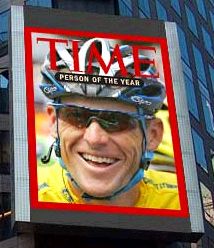
Time magazine is allowing anyone to submit photos of people they want to be “Person of the Year” to be projected on a billboard in Times Square. However, the website states that what they really want is to have people submit photos of themselves. All the photos that are selected to be projected will be photographed by webcam and their owners will be contacted. The images can be viewed, printed and sent to friends.
If the chance of seeing your image on a giant billboard in Times Square in real time is small, what is the difference between having Time photoshop your face onto its cover and doing it yourself? Is it the idea of projecting your image onto a billboard (which can be simulated as well)?
Is this Time magazine diminishing their role as information filter or it is an established news outlet recognizing the idea that anyone can be a publisher?
Category Archives: photoshop
the evils of photoshop?

In a larger essay which bemoans the rise of image culture, Christine Rosen goes after Photoshop and its users in The New Atlantis, a right-leaning journal concerned with the intersection of technology and cultural values. According to Rosen, the software “democratizes the ability to commit fraud,” corrupting its users by giving them easy access to the tools of reality manipulation. She writes:
Photoshop has introduced a new fecklessness into our relationship with the image. We tend to lose respect for things we can manipulate. And when we can so readily manipulate images–even images of presidents or loved ones–we contribute to the decline of respect for what the image represents…
Worrying about photographic fakery isn’t new, of course — as Rosen herself notes, Susan Sontag inveighed against manipulated images in her 1977 work On Photography, and Rosen takes her point that images have been manipulated prior to the age of digitization. Here, however, Rosen’s concern with digital manipulation focuses less on the ability of people to deceive others with altered photos than on the ability of Photoshop to propel its users towards a general irreverence towards the real. This is an interesting inversion of the point that Bob Stein makes in a recent post; namely, that we have less respect for digitally manipulated images than ones which are “real.”
Later in the essay, Rosen suggests that some Photoshop images can be seen as the equivalent of today’s carnival sideshow:
“Photoshop contests” such as those found on the website Fark.com offer people the opportunity to create wacky and fantastic images that are then judged by others in cyberspace. This is an impulse that predates software and whose most enthusiastic American purveyor was, perhaps, P. T. Barnum. In the nineteenth century, Barnum barkered an infamous “mermaid woman” that was actually the moldering head of a monkey stitched onto the body of a fish. Photoshop allows us to employ pixels rather than taxidermy to achieve such fantasies, but the motivation for creating them is the same–they are a form of wish fulfillment and, at times, a vehicle for reinforcing our existing prejudices.
Looking at the Photoshop image above (which I pulled from the first Fark photoshop contest I came across), I can see the root of Rosen’s indignation: there is something offensive about the photo’s casual attitude toward an iconic image. But having seen similarly offensive editorial cartoons that riff on iconic phototographs, I’m not persuaded that Photoshop is the issue. It is true that without Photoshop this image would not have been made; indeed, as Rosen suggests, there is a Photoshop subculture on Fark that promotes the creation of absurd and often offensive images. But can we really make the argument that those who create these images become, in the process, less respectful of the reality they represent? I tend to resist such technological determinism: I would argue, against Rosen, that people manipulate images because they are already irreverent towards them — or, alternately, because they are cynical about the ability of images to represent truth.
